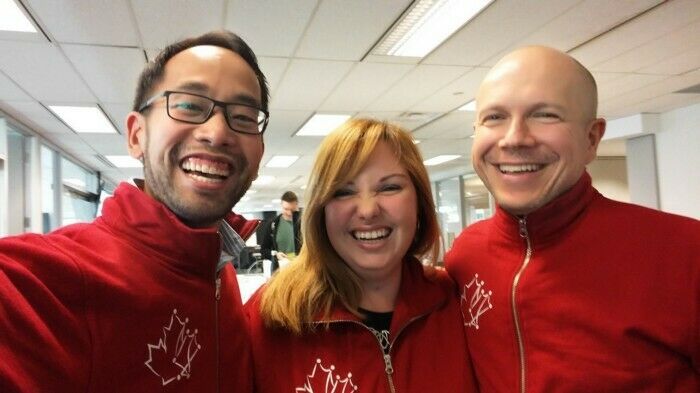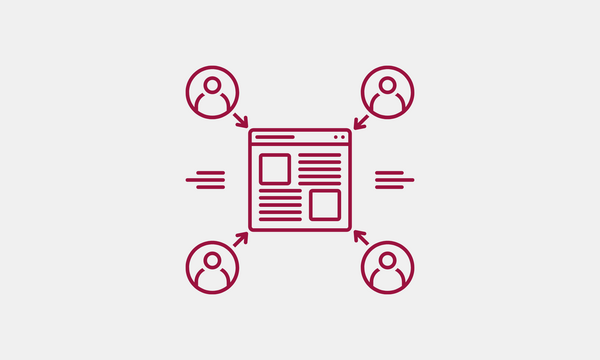Benefits at a Glance

Leon Lukashevsky
January 30, 2018
Meet the team
Hi. We’re the 2017–18 federal Code for Canada fellows. We like to refer to ourselves as Team August (guess what month we were all born in). The team consists of Product Manager Daniel Tse, UX Designer Raluca Ene, and Web & Data Developer Leon Lukashevsky. We’re based out of Ottawa during our fellowship term, where we’re working with the Canadian Digital Service.

Dan is a data analytics consultant from Edmonton, with a background in biomedical engineering. A personal career highlight for him was developing a system to assess substance abuse and mental health risks in remote communities for the Government of Manitoba. Outside work he chases the dream of making the perfect noodle, from scratch.
Hailing from Montreal, Raluca is a UX designer who has helped companies from a wide range of sectors–including finance, education and healthcare–adapt to and innovate on the web. She can beat you at every video game.
Leon is from Toronto. He has developed web apps and data projects with the Centre for Social Services Engineering at the University of Toronto, Sustainability Solutions Group, The Globe and Mail and Influitive. His first love is fiction; he likes anything that involves semicolons.
Veterans Affairs Canada
Last summer, Veterans Affairs Canada’s Online Services team requested that the Canadian Digital Service help them develop “Benefits at a Glance,” a web-based directory of VAC’s benefits. CDS agreed, and decided that the work would be led by us, its first team of Code for Canada fellows.

Veterans Affairs Canada is a department of the federal civil service mandated to help ex-military, ex-RCMP, as well as some still-serving members of both, and their relations (a group I’ll refer to as VAC’s patrons) live a healthy and dignified life. It does so through benefits, which include compensation for injuries incurred in the line of duty, and career transition services.
VAC offers upwards of 40 benefits covering a variety of needs, only a handful of which are (typically) relevant to any given patron. Sorting out which ones, how they work in concert, and how to utilize them effectively can often be a complex and difficult task, for patrons and department staff alike, to the extent that patrons sometimes go without the help they need and are entitled to because they are uninformed — not for a lack of trying.
Benefits at a Glance
VAC’s online resources have their strengths, but feedback suggests their website lacks a meaningful and flexible way of filtering, sorting and searching through the broad set of benefits available to veterans. The department hopes Benefits at a Glance will bridge the gap.
Our collaboration with Online Services began in earnest in mid-November. They provided us with a set of documents outlining the product, and connected us with about 15 stakeholders from across VAC, to help inform our direction. We decided, in response, to begin with a discovery phase, focused on learning about the challenges Benefits at a Glance is meant to address.
We reviewed the documents and began interviewing stakeholders — activities which themselves brought to light more stakeholders to meet and more documents to review. We learned of difficulties related to finding information regarding benefits from a wide cross section of the department including case managers, front-line support staff from VAC’s call centre, benefit application adjudicators, benefit program managers, and staff from the Veterans Ombudsman’s office. We also established a basic understanding of how VAC functions, its organizational goals, major initiatives, its IT infrastructure and web presence, and perused reports on patron-focused user research from recent years.
Thankfully, two CDS design researchers, Mithula Naik and Hillary Lorimer, joined our project during this early stage, to help us conduct interviews, sort through the resources we were absorbing, and document what we were hearing and reading.

Informational Needs at VAC
As we synthesized what we were learning, we came to identify five categories of informational need that VAC patrons and staff have trouble satisfying.
The first two are related to a widespread focus on VAC benefits:
- Discoverability: The need to quickly find what benefits are relevant to a given patron.
- Connectivity: The need to understand how benefits available to patrons connect up, that is, how they are dependent on each other for eligibility, and can work together in concert, including those offered by organizations other than VAC, like the Canadian Armed Forces.
The remaining three needs are related to a specific focus on a given VAC benefit:
- Purpose: The need to understand how a given benefit addresses a patron’s life challenges in practice.
- Process: The need to understand how to successfully apply for a benefit, including the need to determine eligibility conclusively.
- Research: The need to understand what documentation defines a VAC benefit, from the departmental processes and guidelines that control how it is delivered to the legislation it’s derived from.
It is straightforward to imagine how Benefits at a Glance might help satisfy some of these needs in the short term — namely the first couple — whereas the others might require a complementary resource, or an intervention into how the department creates and organizes information about its programming at a more fundamental level (for instance, using simple, clear language, as opposed to jargon, when addressing patrons).
What’s Next
Now that we’ve established the contours of the problem area well enough to navigate it and perceive how Benefits at a Glance might address it, we’ve started working toward an ETP (Earliest Testable Product). We anticipate that developing and testing it with stakeholders and potential users, veterans and internal staff, will be one of our major focuses for the coming months.
As for the informational needs that early versions of Benefits at a Glance likely won’t address or help elucidate, we plan to examine them further via targeted research, which we’ll be undertaking concurrently. We hope that doing so will turn up ideas for how the eventual early versions of the product can be extended or complemented, so that it might address the problem area more fully.
We also plan to document and report back to VAC on any interventions we come to see as necessary that are beyond the scope of the partnership (our fellowship ends in–wait for it–August), especially those that might significantly improve the quality of service the department provides its patrons, our ultimate goal.
We’re very pleased for this opportunity to help veterans better identify and access benefits that can improve their lives. And we’ll be sure to continue to share our progress. So, until next time…
The Code for Canada fellowship embeds technology professionals into government, where they work alongside public servants to build great digital services for residents. To learn more about becoming a fellow, or hosting a team of fellows in your department, visit codefor.ca/fellowship.










